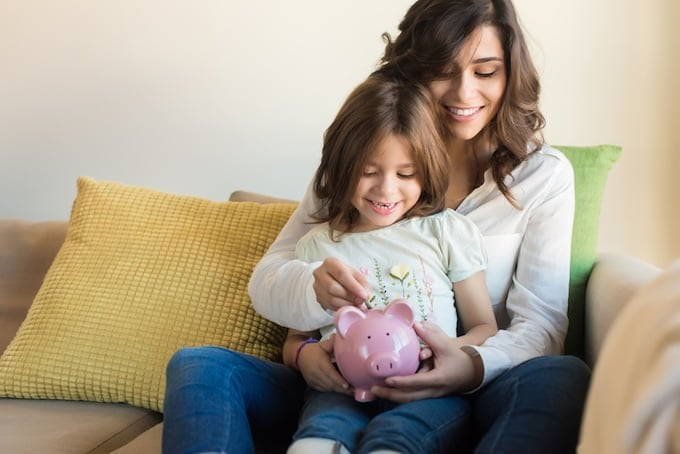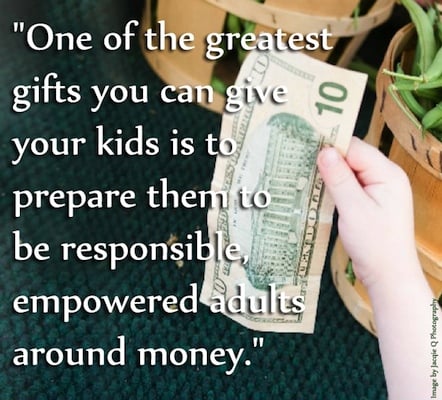How to Raise Kids with Healthy Beliefs About Money
In the age of consumerism and “stuff,” it matters that our kids know what money can and can’t do. Financial wellness expert Sharon O’Day shares how to set them up with healthy money beliefs.

“Read it to me one more time, Mommy.”
And off we go again, hearing how the damsel in distress was swept off her feet by the charming prince … and lived happily ever after.
Unfortunately, that’s probably one of the most insidious things we can put in our little girls’ heads. Yet it was put in ours, and it seems harmless enough to pass along.
What our parents didn’t realize (but we do today) is that those long-ago, childhood memories were often left in that less-visited portion of our brains: the subconscious. And, in many cases, the memories have had a long-lasting negative impact on our adult lives.
The good news is – we do have the power to help build positive beliefs about money within our kids.
How Limiting Money Beliefs Start
From birth to age six, we function almost entirely from our subconscious minds. That is, we have no real ability to judge what’s going on around us. Therefore, everything we hear and experience, every interchange with others, absolutely everything lands in our little subconscious minds, like throwing it all into a huge bucket.
Remember that we all have a biological imperative to survive. So whether we’re functioning from our conscious brains or not, we’re wired to constantly respond to anything that threatens us. (Conversely, we’re attracted to whatever increases our chances to survive.)
A University of Cambridge study about Habit Formation and Learning in Young Children details how a child’s development and learning is highly dependent upon their physical and social environment. According to their research, “Children, being essentially social learners, acquire cultural practices effortlessly and gradually assimilate values, attitudes, standards, norms, knowledge, and behaviors that contribute to financial viability and well-being.”
In other words, kids’ mental money scripts are put in place based on what they observe around them. They are learning about prosperity and limiting beliefs from a very early age.
As infants just learning how the world functions, little ones soak up everything their parents, siblings, and relatives do. They are the role models, after all. Social context shapes attitudes, values, and their entire money belief system, leading to different levels of knowledge and financial behavior.
What we see as memorable incidents could include something as innocent as hearing our parents fighting over money and believing we are somehow the cause…
- Maybe our cousins have toys our parents can’t afford to buy us, and our parents make disparaging comments about how our relatives are selfish rich people.
- Maybe our fathers are always absent, but bring us expensive gifts to show us they love us.
- Maybe we hear that money is the root of all evil.
- Or maybe our mothers unintentionally plant scarcity thoughts in us. Say we grab that yummy treat at the market and she says, “I don’t have any money for that. I barely have enough to put food on the table.”
Whatever the incidents, we each installed millions of these impressions in our infant brains and called them Truth. (I call them Gremlins because of the mischief I see them causing my clients as adults when it comes to money beliefs.)
We had no tools to decide what was right or wrong. Instead, we just left each impression there, whether it was rational or not. Then, as we grew older and acquired the skills of critical thinking, we never bothered to go back and revisit all those old impressions.
Many of these negative beliefs no longer affect us: they were innocuous or they got disproved as we grew up. But, like it or not, some of the more damaging Gremlins that were never addressed still seep into the financial behaviors and decisions we make today in the form of emotional mischief.
“Both abundance and lack exist simultaneously in our lives, as parallel realities. It is always our conscious choice which secret garden we will tend.” ~ Sarah Ban Breathnach
How You Are Influencing Your Child’s Money Beliefs
Now that we know how that works, we have two tremendous opportunities.
First, we can remain vigilant about how our kids might perceive events that, as adults, we consider perfectly harmless. That might seem like a massive task, but becoming a parent is a massive responsibility. And today we’re aware of things our parents never even considered.
We know what obstacles we could be creating for our kids’ future well being. From a little girl who grows up to believe she deserves to find a prince who will take care of her, so she abdicates her power around money… to little boys who become workaholics—putting family relationships at risk—because they can never have enough money.
Just by paying attention to what we say, we can create a positive money mindset in our kids. And when others speak in a way that might create shame or fear around money, we can talk with our child to help reframe those statements before they have a chance to form a scarcity mindset.
How to Encourage Healthier Money Habits
We can plant healthy impressions in our kids’ brains, from infancy onward. Here’s how to encourage feelings of happiness and financial abundance.
Make Money Part of the Conversation
Talk about money around your kids. It’s good for them to know how much things cost, and where you place your priorities.
Recently on a Southwest flight, a mom and an 8-year old boy next to me were talking about first class seats. The boy asked why they never fly first class, and I loved the mom’s response. She calmly said, “Your dad and I would rather spend our money doing fun things on the trip than wasting it all on getting there.”
She didn’t apologize. She didn’t sound ashamed that they “couldn’t afford” first class (which may or may not be true). She stated the facts and sounded confident in her decision.
There are plenty of opportunities to talk about money with your kids. Make sure these are healthy, level-headed conversations. If a discussion comes up between you and your partner that could get heated, table it for another time. Consistently hearing parents argue over money is one of those gremlins that can lead to anxiety or money avoidance later on.
Instead of telling little girls they don’t need to be good at math, as our mothers did, we can encourage them to involve numbers in their daily activities.
That will keep their math skills active so they won’t shut them down as so typically happens in the early teen years. The result will be to remove a huge barrier to being empowered around money.
If we do read fairy tales to our daughters, we can alternate them with stories in which little girls are celebrated for taking care of themselves. (Little boys will benefit as well, as they won’t find themselves expected to go from prince-on-a-white-horse to sole provider forever!)
We can play games with make-believe money, and use that opportunity to introduce the concept of where money comes from and setting financial goals.
Explain the Value of Money
Children today have an even greater challenge than we did. We might still remember putting our hands into our little pockets and pulling out wrinkled dollar bills and coins. It was painful handing our precious money to the nice store owner in exchange for some candy… and watching our money disappear into a big cash register.
But today, it’s all too easy for kids to think money appears miraculously (and effortlessly) from a plastic card, our phones, or a machine.
All you have to do is walk up to that wall, slide a piece of stiff plastic into a slot, push a few buttons and voilà! —out comes money.
The relationship between money and someone’s effort to earn that money is more tenuous than ever. Even worse, we now call money “funds,” and send them around the world at the click of a mouse.
At the appropriate age, kids can be taught that, while the total amount of money in the world is virtually limitless, the amount available to them (or to the family) at that moment is limited and has to be allocated based on needs and priorities. How that is done is up to each parent’s beliefs, but the important thing is that it be done.
We cannot function effectively in the world without a healthy relationship with money. So don’t ask your kids to live without such a relationship in the future because you were a little uncomfortable teaching them about it today.
You won’t be doing them any favors by protecting them from that bugaboo called money—through silence or by indulging. In fact, one of the greatest gifts you can give your kids is to prepare them to be responsible, empowered adults around money.
You can do that by making it part of your awareness every day … and part of the family conversation when the time is right.
Encourage Gratitude
One of the laws of the universe is that what we focus on expands. We experience it every day. Wake up to one bad thing and tell yourself, “Well, this is gonna be a terrible day” and you’ll find no shortage of ways to be right. That’s because you’re looking for things to confirm your belief.
Conversely, when you look for things to be happy or delighted about, you’re sure to find them as well! Being thankful for what you have opens you up to more. It also instills a sense of peace which means you’re less likely to turn to retail therapy when you’re looking for fulfillment.
Practice some of these positive affirmations for abundance with your kids. They can help build comfort, appreciation, and peace of mind around prosperity.
I am open and receptive to all good.
Abundance flows through me.
There is enough for everyone.
Money flows to me in expected and unexpected ways.
I am thankful for all that I have.
And try one of these guided meditation scripts for gratitude: The Thankful Turtle Meditation or Thankful Heart on a Lazy River guided imagery.
Teach Kids That Being Conservative with Money Doesn’t Mean You’re Poor
For some socially and eco-conscious families, there can be a shadow side to thrift and conservation. As a parent, your choice to opt out of the consumerism cycle may be perceived as an inability to afford the latest trends and gadgets. Your eco-friendly backyard birthday party is quite the contrast to the laser tag or day at the spa invitation from your child’s classmate.
While you know (and have probably extensively researched) the reasons behind your anti-consumerism lifestyle, frugality can be a hard place from which to parent. When your child compares herself with her peers, she may not understand that not having 20 pairs of shoes is conscious choice… not a sign her family is poor.
Kids’ Books to Build Positive Beliefs About Money
Here are some books (some for parents, some for kids) to help encourage questions and positive habits with money and finances.
Raising Financially Confident Kids by Mary Hunt
The Opposite of Spoiled: Raising Kids Who Are Grounded, Generous, and Smart About Money by Ron Lieber
A Chair for My Mother (Reading Rainbow Books) by Vera B. Williams
A Smart Girl’s Guide to Making Money (American Girl) by April Lundsten
Bunny Money by Rosemary Wells
Alexander, Who Used to Be Rich Last Sunday by Judith Viorst
Those Shoes by Maribeth Boelts
How to Turn $100 into $1,000,000: Earn Save Invest by by James McKenna & Jeannine Glista
No Excuses! How What You Say Can Get in Your Way by Wayne Dyer
Lemonade in Winter by Emily Jenkins
National Geographic Kids Everything Money: A wealth of facts, photos, and fun by Kathy Furgang
Toys + Tools to Encourage Healthy Money Habits
And these toys and games are perfect for starting money conversations.
Save, Share, Spend Moneybox by Moonjar
Calculator Cash Register by Learning Resources
The Allowance Game
Smart Piggy Trio Bank
Pretend & Play Checkbook & Calculator
Play Money by Melissa & Doug


